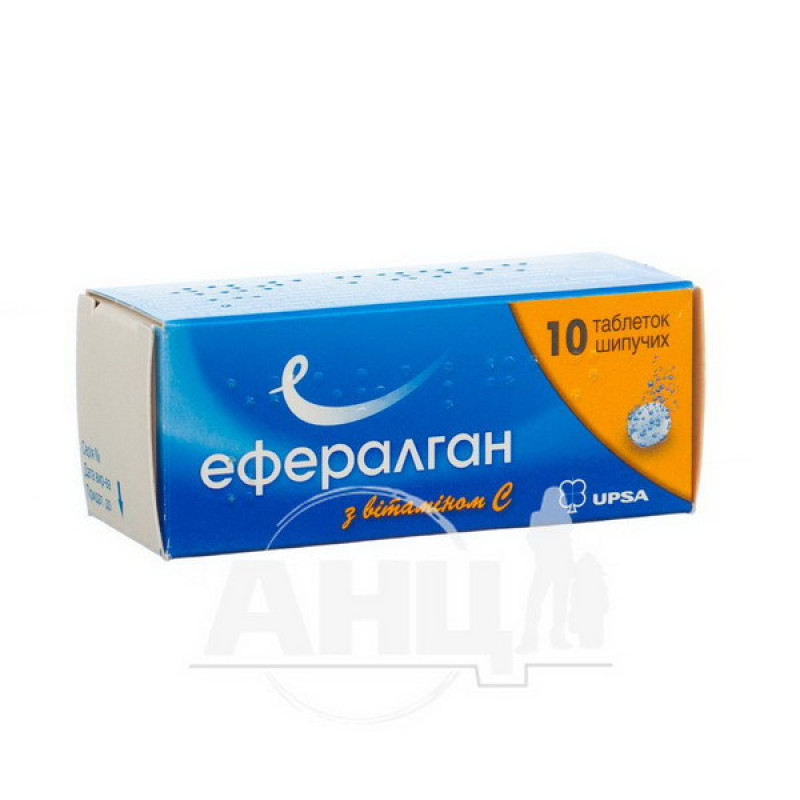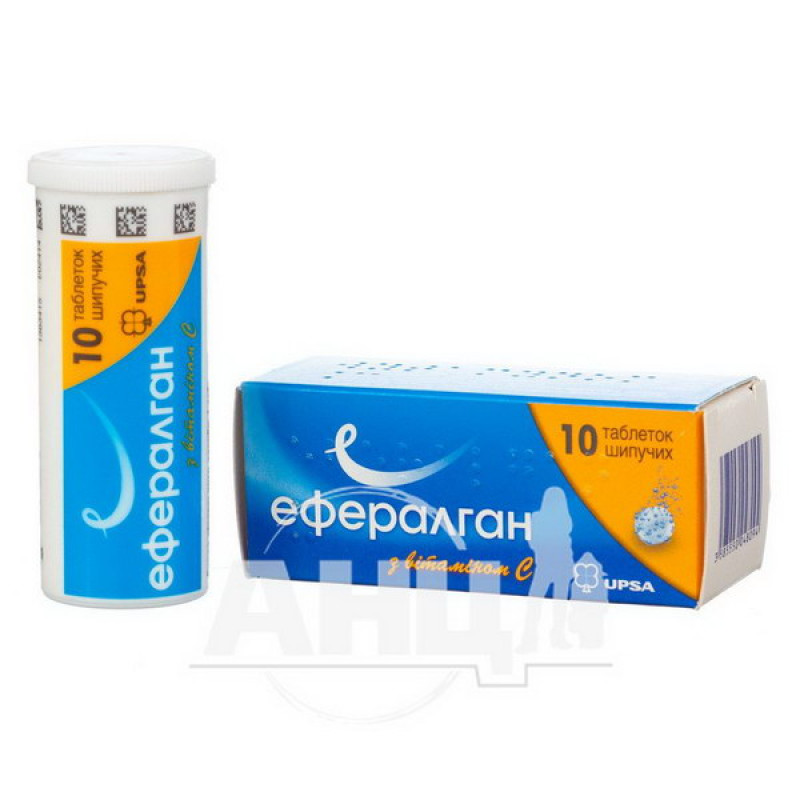Efferalgan with vitamin C effervescent tablets tube No. 10

Efferalgan effervescent tablets with vitamin C are used for the symptomatic treatment of mild to moderate pain and/or fever.
Composition
One effervescent tablet contains (active ingredients):
paracetamol - 330 mg; ascorbic acid (vitamin C) - 200 mg.Excipients: potassium bicarbonate, anhydrous citric acid, sodium bicarbonate, sorbitol (E 420), sodium benzoate (E 211), docusate sodium, povidone.
Contraindication
hypersensitivity to the components of the drug; urolithiasis, when using large doses (more than 1 g) of ascorbic acid; severe liver and/or kidney dysfunction, congenital hyperbilirubinemia, glucose-6-phosphate dehydrogenase deficiency, blood diseases, severe anemia, leukopenia; thrombosis, tendency to thrombosis, thrombophlebitis, diabetes mellitus, urolithiasis; alcoholism.Method of application
For oral use.
Completely dissolve the tablet in a large glass of water and drink immediately.
The drug is used in adults and children over 8 years of age (with a body weight of more than 27 kg). The recommended daily dose of paracetamol is approximately 60 mg/kg. The daily dose should be divided into 4 or 6 doses, i.e. approximately 15 mg/kg every 6 hours or 10 mg/kg every 4 hours.
Children should follow the dosages established depending on the child's body weight, so it is necessary to choose the appropriate form of release. The approximate ratio of age and body weight is given only as an example:
children weighing 27 to 30 kg (approximately 8-10 years): the dose is one effervescent tablet per dose (if necessary, the dose can be repeated after 6 hours, but not more than 5 effervescent tablets per day); children weighing 30 to 35 kg (approximately 10-12 years): the dose is 1-2 effervescent tablets per dose (if necessary, the dose can be repeated after 6 hours, but not more than 6 effervescent tablets per day); children weighing 35 to 50 kg (approximately 12-15 years): the dose is 1-2 effervescent tablets per dose (if necessary, the dose can be repeated after 6 hours, but not more than 7 effervescent tablets per day); adults and children weighing over 50 kg (approximately 15 years and older): the dose is 1-2 effervescent tablets per dose (if necessary, the dose can be repeated after 4 hours, but no more than 9 effervescent tablets per day).Usually, you should not use more than 3 g of paracetamol per day, i.e. more than 9 effervescent tablets per day. Although for more severe pain, the maximum dose can be increased to 4 g per day, i.e. up to 12 effervescent tablets per day.
The interval between doses should be 4 hours.
Maximum recommended doses:
children weighing less than 37 kg - the total dose of paracetamol should not exceed 80 mg/kg/day; children weighing from 38 kg to 50 kg - the total dose of paracetamol should not exceed 3 g/day; adults and children weighing more than 50 kg - the total dose of paracetamol should not exceed 4 g/day.Frequency of treatments. Regular treatments help avoid fluctuations in pain and fever:
In children, a regular interval between doses is recommended both during the day and at night - 6 hours, but not less than 4 hours; in adults, the interval between doses should be at least 4 hours.Since the medicine contains vitamin C, it should not be taken at the end of the day.
Application features
Pregnant women
In clinical trials, the results of epidemiological studies allow us to exclude any malformations or fetotoxic effects that may be associated with paracetamol. Therefore, provided that paracetamol is used in recommended doses, the drug can be prescribed during pregnancy, taking into account the benefit/risk ratio.
Paracetamol passes into breast milk, but in clinically insignificant quantities. Available published data do not indicate any contraindications to breastfeeding. In therapeutic doses, this drug can be used during breastfeeding, but with frequent use, the benefit/risk ratio should be considered.
Drivers
The drug does not affect the reaction speed when driving vehicles or other mechanisms.
Overdose
Symptoms of paracetamol overdose
There is a risk of poisoning in elderly patients and especially in young children (both therapeutic overdoses and accidental poisonings are common) and poisoning can be fatal.
Symptoms
Nausea, vomiting, pallor, anorexia, and abdominal pain usually occur within the first 24 hours.
A single dose of 10 g in an adult and 150 mg/kg of body weight in a child can lead to impaired glucose metabolism, hemorrhage, hypoglycemia. Acute renal failure with acute tubular necrosis can develop even in the absence of severe kidney damage and manifest as severe pain in the lumbar region, hematuria, proteinuria. Cardiac arrhythmia and pancreatitis have also been noted. With prolonged use of the drug in large doses, aplastic anemia, pancytopenia, agranulocytosis, neutropenia, leukopenia, thrombocytopenia may develop from the hematopoietic system.
In patients with risk factors (long-term use of carbamazepine, phenobarbital, phenytoin, primidone, rifampicin, St. John's wort or other drugs that induce liver enzymes, alcohol abuse, insufficiency of the glutathione system, for example, malnutrition, AIDS, starvation, cystic fibrosis, cachexia), the use of 5 g or more of paracetamol can lead to liver damage.
An overdose of more than 10 g of paracetamol per dose in adults and 150 mg/kg of body weight per dose in children causes hepatic cytolysis, which can lead to complete and irreversible necrosis, resulting in hepatocellular failure, metabolic acidosis, and encephalopathy, which can lead to coma or death.
Simultaneously, elevated levels of hepatic transaminases, lactate dehydrogenase, bilirubin, and an increase in the prothrombin index are observed, which may develop within 12-48 hours after overdose.
Symptoms of ascorbic acid overdose: epigastric pain, nausea, vomiting, flatulence, diarrhea, itching and skin rashes, increased excitability of the nervous system.
With prolonged use in high doses, inhibition of the insular apparatus of the pancreas, development of cystitis, acceleration of the formation of concrements (urates, oxalates, cystine stones), and myocardial dystrophy are possible.
Emergency measures
In case of overdose, urgent medical attention is required, even if there are no symptoms of overdose. Urgent removal of the used drug by gastric lavage when taken orally. The appointment of methionine orally or acetylcysteine may have a positive effect within 48 hours after overdose. It is also necessary to use general supportive measures, symptomatic therapy.
Side effects
At recommended doses, the drug is usually well tolerated, but the following side effects may occur:
allergic reactions: anaphylaxis, anaphylactic shock, angioedema, erythema multiforme, urticaria, skin rash and itching, rash on the mucous membranes, Stevens-Johnson syndrome, toxic epidermal necrolysis (Lyell's syndrome); from the blood and lymphatic system: anemia, sulfhemoglobinemia and methemoglobinemia (cyanosis, shortness of breath, heart pain), hemolytic anemia; thrombocytosis, erythrocytopenia, thrombocytopenia, thrombocytopenia, neutrophil leukocytosis, hyperprothrombinemia, thrombocytopenia, leukopenia and neutropenia in patients with glucose-6-phosphate dehydrogenase deficiency of blood cells can cause hemolysis of erythrocytes, bruising or bleeding; from the respiratory system: bronchospasm in patients sensitive to acetylsalicylic acid and other nonsteroidal anti-inflammatory drugs; From the digestive tract: dyspeptic disorders, nausea, vomiting, epigastric pain, heartburn, diarrhea; From the liver: increased activity of liver enzymes, usually without the development of jaundice, hepatonecrosis (dose-dependent effect), impaired liver function; From the endocrine system: hypoglycemia, up to hypoglycemic coma; From the kidneys and urinary system: damage to the glomerular apparatus of the kidneys, crystalluria, formation of oxalate, cystine, urate stones in the kidneys and urinary tract, renal colic; From the nervous system: headache, feeling of heat, increased excitability, sleep disturbances; From the metabolism: impaired metabolism of zinc, copper; From the cardiovascular system: fluctuations in blood pressure.If any adverse reactions occur, the drug and similar medications should be discontinued immediately and a doctor should be consulted.
Storage conditions
Store at a temperature not exceeding 25 °C in a tightly closed tube and cardboard packaging. Keep out of the reach of children.
Shelf life - 3 years.
There are no reviews for this product.
There are no reviews for this product, be the first to leave your review.
No questions about this product, be the first and ask your question.



